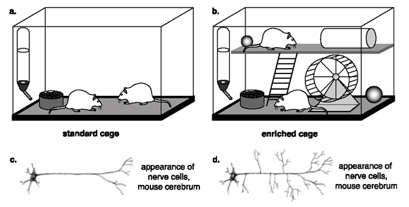Month 44
Each time a child is stimulated to think, either new neural bridges are formed or pre-existing ones are strengthened. The more neural bridges formed or strengthened, the more the intellect will be developed.
The brain’s ability to change and reorganize in response to some input is known as plasticity. Plasticity is defined by a change in the anatomy of the neuron. New synapses may form, existing synapses may strengthen, and some synapses may be eliminated. Factors have been identified that can function as positive or negative regulators of neural plasticity.
Positive regulators of neural growth:
Studies have revealed that physical, social, and mental activity may protect memory and alertness. For example, mice raised in an “enriched” environment, which contains other mice and a variety of stimulating toys, displayed dendrite growth and performed better on learning tasks than inactive, isolated mice.

Mice raised in an impoverished environment (a) show less dendrite growth (c) than do mice raised in an enriched environment (b, d)
Negative regulators of neural growth:
One negative regulator of neural growth is deprivation, the opposite of the positive factor of enrichment. Mice, rats, nonhuman primates, and humans all show lower ability to learn tasks and less dendrite branching when raised in environments deprived of stimulation.
Poor nutrition, lack of social contact, and absence of mental engagement can all contribute to deprivation. Another major factor known to have a negative effect on neural growth is stress. Scientists have shown consistently that animals and humans living under constant stress conditions show less neural growth and/or learning than their less-stressed counterparts.
How I think @ 44 months
Your child is developing word vocabulary and word association skills: this skill usually develops for children between 3 year 4 months and 4 year 2 months. To help him with his concentration, make sure that the study environment is organized and physically cut off from all distractions.
Motor Development: Gross Motor Skills
• I can stand on one foot for five seconds
• I may be able to hop on one foot
• I can broad-jump
• I can toilet myself during daytime
Motor Development: Fine Motor Skills
• I can build a tower of nine small blocks
• I can drive nails and pegs
• I can copy a circle
Language and Thinking Development
• I know my last name, name of street on which I live and several nursery rhymes
• My grammar skills are improving as well; while I may still have problems using the correct tense of verbs or matching up subject-verb agreement, these errors are increasingly rare
• I understand the concept of "two”
Social and Emotional Development
• I am learning to form my own friendships, based on similar likes and dislikes
• I like to share and have begun to use “we”
• I may have begun cooperative play with other children
Activities
Disclaimer: This presents an overview of child development. It is important to keep in mind that the time frames presented are averages and some children may achieve various developmental milestones earlier or later than the average but still be within the normal range of development. This information is presented to help parents understand, at a high level, what to expect from their child. Any questions/concerns you may have about your child’s development should be shared with your doctor.




